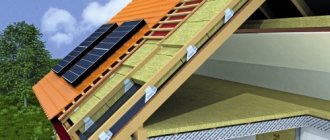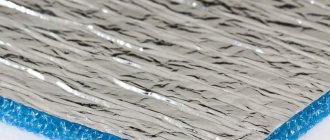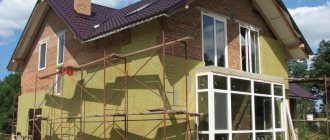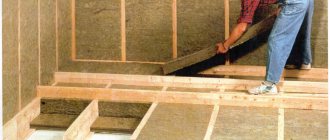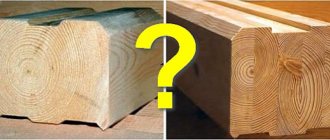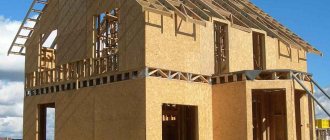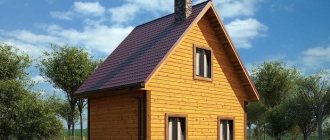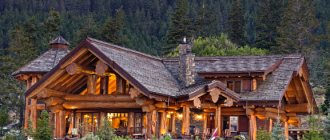The main quality of a good home is the ability to retain heat for a long time without loss, and therefore you should be especially careful when choosing insulation. The modern market of thermal insulation materials includes about 15 types of insulation. We have selected 9 of the most effective ones that are suitable for any structure
Read in the article:
- Mineral (stone) wool
- Extruded polystyrene foam
- Liquid foam
- Cork insulation
- Foam glass
- Ecowool
- Sawdust
- Straw
- Hemp and flax
1
Mineral (stone) wool
Rock wool is one of the most common and sought-after insulation materials on the market, and there are several reasons for this.
High heat saving ability
. The thermal conductivity of stone wool varies from 0.035 to 0.042 W/(m*K). In other words, a 10 cm thick layer of this material retains heat as well as 25 cm of timber or 117 cm of brickwork.
Fire safety.
Stone wool does not burn or smolder, because the melting point of basalt fibers exceeds 1000°C.
Vapor permeability.
Thanks to its relatively loose, “airy” structure, stone wool allows water vapor to pass through, which is formed in the house as a result of human activity (showering, cooking, washing, etc.). This means there is no need to worry about mold formation.
Sound absorption ability.
The same fibrous structure makes mineral wool a good sound insulator. So, when covering facades with stone wool, you can solve two problems at the same time: the house will become both warm and quiet.
Resistance to aggressive environments.
Mineral wool insulation is not afraid of mold, mildew and aggressive chemicals. And of course, “foamed stone” does not arouse food interest among insects and rodents.
Light weight.
A package of slabs with a total area of 0.35 m² weighs from 10 to 70 kg (depending on the thickness of the material). Thanks to its relatively low weight, both transportation and installation are facilitated.
Minor shrinkage.
Unlike many loose materials, stone wool almost does not lose volume over time. And that means heat-saving properties.
Durability
. The material retains its performance characteristics for 70-100 years.
Mineral wool in rolls
Mineral wool in slabs
Briefly about the main thing
Insulation plays an important role in construction and renovation. You can find a huge number of insulation materials on the market, each of which has its own characteristics and disadvantages.
“Technoplex” and “Penoplex” are similar in technical characteristics. Both materials have high density and can withstand significant weight, and are characterized by low vapor permeability and thermal conductivity. They also have similar disadvantages. Both insulation materials ignite easily and release hazardous substances.
The choice is most often made in favor of Penoplex. This is due to the low price and the ability to use sheets for external insulation.
Other materials can be used for insulation: mineral wool, polystyrene foam and others. Each of them has its own characteristics.
Flaws
High price.
Basalt wool is quite expensive. One cubic meter of material costs from 1,500 to 6,500 rubles. (depending on density and a number of other factors). Such a high price tag is primarily due to the complexity of production and the need to use expensive equipment, in particular blast furnaces.
Use of environmentally unsafe materials.
Stone wool consists of more than 95% of stone itself, but it cannot be called an absolutely natural product. To prevent the boards from falling apart into fibers, manufacturers are forced to use binders, in particular formaldehyde resins. Of course, self-respecting companies use them in minimal quantities, but there is always the possibility of “running into” a low-quality product that emits toxic fumes.
There is only one way to minimize risks - by checking the documents for the products. The laws of the Russian Federation require manufacturers of heat-insulating materials to obtain a Fire Safety Certificate, as well as an Expert Opinion on compliance with current sanitary standards and rules.
Types of stone wool
Basalt-based insulation is available in several modifications. Rolled fabric (the width of which is usually 1.2 m, and the length varies from 7 to 12 m), from most manufacturers has a low density - only 35 kg/m³. This material can only be used for horizontal laying in areas without any load. Such solutions do not occur very often.
The large area of the rolled fabric allows it to be laid with a minimum number of seams, and therefore cold bridges
The most popular is stone wool in the form of slabs (dimensions 0.6-1 m by 1.2 m and thickness from 30-200 mm). The main factor determining the scope of their application is density. Depending on this, the material is divided into several grades.
P-75
(density 75 kg/m³). Used for insulating surfaces with minimal load, for example, interior partitions and ceilings.
P-125
(125 kg/m³). Suitable for thermal insulation of floors, interfloor ceilings and facades.
PZh-175
(175 kg/m³). Designed for thermal insulation of reinforced concrete and metal walls and ceilings.
PPZh-200
(200 kg/m³). The material of maximum density is used for insulating roofs and floors under screed.
What is the best way to insulate facades – from the inside or the outside?
There are three options for positioning the insulation relative to the wall.
The first one is from the inside.
This method has few advantages. This is ease of installation (working indoors is more comfortable than outdoors) and there is no need to protect the insulation from harsh external influences. The disadvantages are much more significant. First of all, this is a loss of precious usable space. And the greater the thickness of the insulation, the less free space.
Another disadvantage is the risk of the walls getting wet. Stone wool is a vapor-permeable material. Water vapor passes through it unhindered, after which it begins to accumulate at the “cold wall-insulation” boundary or in the thickness of the wall. So, when choosing this installation method, you need to install a vapor barrier on the side of the room and organize effective (possibly forced) ventilation.
If you place the insulation outside
, the so-called dew point (water vapor condensation zone) will shift into the thickness of the mineral wool, from where the liquid will evaporate naturally. This means that the wall will no longer get wet.
In addition, external insulation protects the wall from alternate freezing and thawing, which has a beneficial effect on the “weather in the house.” And of course, if the mineral wool is located outside, there can be no talk of any loss of usable space.
The disadvantage is that the insulation has to be protected from atmospheric moisture and mechanical damage by covering it with plaster (wet facade) or cladding panels (hinged ventilated facade).
And finally, the third way. In this case, the insulation is laid on the outside of the wall and covered with facing bricks
. In this case, stone wool is reliably protected from external influences, there is no loss of usable area and other disadvantages described above. The only problem is that this solution is optimal only for buildings under construction. It is problematic to insulate an already finished house in this way, since increasing the thickness often requires strengthening (remodeling) the foundation.
Read more in the article “Pele’s Hair”
2
Extruded polystyrene foam
Extruded polystyrene foam (EPP) is a progressive and modern material; it is quite closely related to the polystyrene foam familiar to each of us. Both insulation materials are made from polystyrene, but using fundamentally different technologies. And this causes significant differences in consumer properties.
Extruded polystyrene foam XPS
During the production of polystyrene foam, polystyrene granules are repeatedly treated with hot steam, which is why they increase in volume.
But at the same time, the micropores of the material increase. At first, the insulation copes with its duties perfectly. But over time, under the influence of moisture and other aggressive factors, it simply crumbles into individual grains. Although even polystyrene foam that has just “come off the assembly line” has rather low strength. It crumbles easily and has almost no resistance to bending.
In the case of extruded polystyrene foam, the granulated raw material is placed in a reactor where it is subjected to heat and pressure.
Then, when the polymer melts, the pressure is released, which leads to active foaming, and the resulting mass is passed through an extruder.
The result is a material consisting of closed cells with strong molecular bonds. This implies the main advantage of extruded polystyrene foam. It is approximately 5 times stronger than polystyrene foam.
Extruded polystyrene foam is an effective insulation material. A 10 cm thick EPP board retains heat as well as a 150 cm thick brick wall.
Lightweight, usable roof system for pedestrian loads with plastic supports.
High strength allows the EPP to withstand quite significant loads, and this, in turn, provides a wide range of applications. This insulation is used not only for walls and ceilings, but also for foundations, blind areas, and used roofs. It is used to fill well masonry during the construction of brick houses. It is included in the design of many sandwich panels.
It is also worth noting that polystyrene foam is an exceptionally lightweight material.
It puts virtually no load on the walls and foundation, and also does not create problems during installation
.
The slabs lend themselves perfectly to mechanical processing, and glue and dowels are enough to secure them to the walls.
An important advantage of polystyrene foam is its almost complete waterproofness.
. Even when dipped, it absorbs less than one percent of the liquid.
But unfortunately, EPP has quite noticeable disadvantages.
The first, and probably the main one, is
extremely low vapor permeability.
In simple words, this material does not “breathe” well. You should not insulate the walls from the inside with it - settling condensation will lead to the formation of mold. Experts recommend using this heat insulator outside and covering it with plaster. You can also lay polystyrene foam boards inside frame structures, but it is extremely important to create an air gap for proper ventilation.
Like regular polystyrene foam, extruded polystyrene foam is “afraid” of certain chemical reagents.
For example, bitumen mastics, which are used as waterproofing. Under their influence, EPP becomes soft and sometimes even dissolves.
To avoid blowing through the seams, EPP boards should be laid in two layers, with bandaging
More details in the article “Foam plastic”
3
Technology for insulating a brick wall with expanded clay
Since expanded clay is a bulk material, for its use it is necessary to organize a frame into which it will be poured. Therefore, this method of insulation is usually used in three-layer wall structures.
It is necessary to understand: the introduction of expanded clay must be carried out gradually as the masonry grows, and not filled in from the attic when the wall has already been erected.
Method 1: lightweight well masonry
The essence of the method is to lay out 2 layers of a wall structure made of brick or brick with blocks in rows, the distance between them should be 15...30 cm. The colder the region, the wider the gap between the rows. After every 1-2 rows, the masonry is tied with brick lintels across the entire thickness of the wall in increments of 50-70 cm. As the structure grows, insulation is poured into the formed wells every 30-50 cm, carefully compacting it. To bind the granules, they are watered with a liquid cement solution (milk). This will prevent the expanded clay from settling in the closed wall.
Method 2: well masonry with rigidity diaphragms
This method is optimal for brickwork. Ribbons of the inner and outer walls are laid out with a thickness of 1 and ½ bricks, respectively. The outer row can be laid out of facing bricks, ceramic blocks (it is necessary to ensure that when strengthening the masonry, the levels of opposite rows coincide), concrete blocks for plaster, or sand-lime brick. The distance between the tapes remains the same 10...30 cm. The corners are made solid to create structural rigidity.
Expanded clay is poured after every fifth row of masonry, compacted and filled with cement laitance. After this, a brick rigidity diaphragm is laid out over the entire thickness of the wall. This avoids the use of dressing anchors and creates structural rigidity in height. The only drawback of the method that may arise is that if the expanded clay is insufficiently compacted, after it settles slightly, it will be impossible to get inside the wall to fill the empty space.
Method 3: masonry with embedded parts
This method is similar to the construction of lightweight masonry, only instead of brick lintels, metal or fiberglass anchors are laid in the structure in increments of 40-60 cm. This results in less brick consumption, there is no need to calculate the steps for masonry, and the strength remains at a high level. Expanded clay is also poured onto every 30-50 cm of the wall; in such a volume it is easier to compact it and soak it in milk of cement.
Liquid foam
Externally liquid foam (penoizol)
looks like elastic white foam, more than 90% consisting of air bubbles, which, in fact, provides a heat-saving effect.
According to the companies using this material, 10 cm of such insulation is equal to 30 cm of ordinary board foam, 20 cm of mineral wool or 2.5 m of brickwork.
Such impressive characteristics are largely due to the fact that the material is applied under pressure. Increasing in volume, the foam penetrates into the smallest depressions, cavities and cracks, forming a continuous heat-insulating layer without cold bridges.
High adhesion allows the use of liquid polystyrene for internal insulation of vertical and inclined planes, for example, attic roofs
Foamed foam insulation can be used to insulate almost any enclosed space: layered brickwork, false wall cavity, attic floor, etc.
Penoizol is especially popular among companies reconstructing old houses. After all, in order to insulate a building, you do not need to remove the façade cladding or dismantle the ceilings.
Penoizol can also be used outside the home. For example, it is used to insulate the walls of wells. To do this, you just need to make permanent formwork, spaced 3-5 centimeters from the outer walls of the shaft, and foam the resulting space.
Although carbide foam contains organic resins, it effectively resists fire and is self-extinguishing. According to the current classification in the Russian Federation, this insulation belongs to the flammability group G1 (low-flammability)
So, we have looked at the advantages of liquid foam, and there are quite a few of them. But, studying construction forums, you might think that penoizol is perhaps the worst material for insulating private houses. Of course this is not true. Most of the negative reviews are due to the fact that unscrupulous companies, seeking to save money at any cost, use low-quality raw materials and work “carelessly.” And yet it should be noted that this technology does have drawbacks.
The first, and perhaps the main one, is the environmental unsafety of the material.
. Liquid foam contains formaldehyde, which emits toxic fumes. Yes, they weather over time, but finishing work cannot be carried out in the house for another two weeks after insulation. And that's the minimum. It is advisable to wait a month or a month and a half with the “inner stuff” so as not to risk your health. As for finishing facades and other outdoor activities, there are no strict restrictions. But we repeat – it’s better not to take risks.
In addition, the relatively high hygroscopicity of liquid foam should be taken into account. Some companies add moisture-repellent agents (hydrophobizers) to the raw materials, and this minimizes the problem. But it doesn't solve it completely. Therefore, it is impossible to use liquid foam to insulate foundations and other areas that have direct contact with the soil.
Due to its low density, penoizol is categorically not suitable for insulating floors under screed. And the last problematic factor is shrinkage. Foam applied under pressure “deflates” over time. As a rule, it is insignificant - only 1-4%. But the heat-saving properties of the material are somewhat reduced.
To ensure that foam settlement is not critical, it should be applied in compliance with certain rules. So, in one pass, the material is applied to a height of no more than 3 m. But it is better to limit it to a height of 1 m. And only when the foam has slightly set, work can be resumed.
Read more in the article “Light foam”
4
Cork insulation
Cork insulation is made from granulate - a piece of bark from which a panel of acceptable sizes can be cut does not exist in nature. No synthetic glues are used; the binder is the lingin contained in the bark. However, environmental friendliness is not the main advantage of the material.
Cork oak bark is an amazing raw material. Structurally, it resembles a honeycomb: each cubic centimeter contains hundreds of thousands of tiny cells. They are filled with air, which makes up almost 90% of the total volume. This makes cork the most effective natural heat insulator. It has the same thermal conductivity coefficient of 0.037–0.04 W/m K (at t = 25°C) as mineral wool.
A 30mm thick cork panel retains heat as well as a 40cm thick brick wall or a 15cm thick timber wall
The building material of the cells is the aforementioned lignin, which not only glues the granules together, but also provides elasticity to the material, as well as suberin, a waxy substance impermeable to water. Yes, despite its wood origin, cork is completely impervious to moisture
. Wet insulation is as effective as dry insulation.
It is also worth noting that there is practically no protein in cork, which serves as a breeding ground for harmful microorganisms.
But it contains a lot of tannin - tannin. This is what explains the durability of the material. By insulating your house with cork panels, you can forget about the problem forever - their lifespan is calculated in centuries. And these are not nice words from manufacturers: there are buildings with a centuries-old history that still have cork finishes to this day.
Another undeniable advantage of cork is its lightness.
One cubic meter weighs on average from 100 to 120 kg, which means it will be quite easy to install. And the load on the foundation will be minimal. This is especially important for wooden and frame structures that rest on piles or a monolithic strip foundation.
Despite its woody nature, cork is almost not subject to fire. When in contact with a flame, it does not light up, but only slowly smolders
Depending on the thickness (which varies from 5 to 30 cm), the slabs can be used to insulate walls, floors and roofs. This is a universal insulation. But why hasn’t this material displaced all other insulation materials from the market? The main limiting factor is price. Unfortunately, cork is a rather expensive material. The price for 1 m² 5 cm thick is 2277 rubles. (as of February 2022) But for effective thermal protection you need a layer at least 10 cm thick. Obviously, the cork “costs a pretty penny.” But, nevertheless, she is in demand.
Insulation of walls with cork
Cork in roof insulation
Cork in a green roof design
Read more in the article “Tested!”
5
Thermal conductivity
Each insulation has its own thermal conductivity coefficient. This indicator is measured in W/(m*K) and means heat loss per m². For example, a material with a coefficient of 0.02 W/(m*K) gives a heat loss of 0.02 W per sq.m. Therefore, the higher this indicator, the colder it will be in the house.
Here are the thermal conductivity coefficients of the main insulation materials:
| Name of insulation | Indicator W/(m*K) |
| PPU (polyurethane foam) | 0,020-0,035 |
| Penoizol | 0,028-0,035 |
| Ecowool | 0,030-0,040 |
| Styrofoam | 0,035-0,040 |
| Minvata | 0,038-0,048 |
| Glass wool | 0,039- 0,052 |
| Foamed polyethylene | 0,044 — 0,051 |
| Fibrolite | 0,080-0,010 |
It turns out that to achieve the same effect, you need to lay 50 mm of polyurethane foam or 100 mm of mineral wool on the surface. You will need a little less polystyrene - about 80 mm.
Thermal water properties of polyurethane foam are impressive. A layer of 8 cm is equal in ability to retain heat to 55 cm of wood, 64 cm of expanded clay, 80 cm of aerated concrete and one and a half meters of brick. Therefore, in terms of thermal conductivity, polyurethane foam clearly outperforms its competitors.
Mode of production
The material is obtained as follows. At the first stage, a mixture (charge) is prepared from finely ground silicate glass and a carbon-containing gas former, which can be coal coke, anthracite, limestone or marble. Then the mixture is sent to a tunnel furnace, where at a temperature of about 900–1000°C the glass particles are softened to a viscous-liquid state, and gaseous CO2 and CO released as a result of carbon oxidation foam the glass mass, forming closed pores in it. The final product can be presented in the form of granules and crushed stone of different fractions, slabs, blocks. Let's talk about the most popular forms of foam glass in private housing construction.
Thanks to its exceptional properties, foam glass (otherwise known as cellular glass) can provide excellent heat and sound insulation of various building structures: roofs, walls, ceilings, etc.
Granular foam glass
Foam glass in the form of granules is the optimal heat insulator for floors on the first floor of a building. Unlike, for example, expanded clay concrete, the material is not hygroscopic, which means there are no conditions for wood to rot. The vapor permeability of expanded clay is 0.21 mg/(m•h•Pa), and foam glass is 0.001–0.005 mg/(m•h•Pa), moreover, it has half the density, so when producing heat-insulating backfill, You can get by with a layer half as thin. But as for the price, there is a clear advantage of expanded clay, which costs significantly less than granulated foam glass: 1450–2750 rubles. versus 6,000-12,000 rubles. per cubic meter.
Price
The cost of foam glass is steep. Prices, of course, vary, as they depend on many factors, but on average you can buy blocks by paying $120–400 per cubic meter. You can purchase slabs and shells by paying $110–350, and you can get a granular version by spending $35–100 per cubic meter.
What can we say? Insulation with foam glass is a very dubious and costly undertaking, since the material has a lot of serious drawbacks, and, in addition, is incredibly expensive. But, as they say, the master is the master. Maybe it’s not for nothing that they call it the raw material of the future. To buy or not to buy? That is the question! The choice is yours, dear readers.
Warmth and comfort to your home, dear friends! See you on other blog pages!
Wisdom quote: Reading is the best teaching (A.S. Pushkin).
Foam glass slabs
A wide range of foam glass slabs and blocks designed for insulating various structural elements.
Foam glass slabs are a universal insulation material. In addition to excellent thermal insulation properties, they have high vapor and water resistance and exceptional strength. Foam glass has established itself as a material suitable for the construction of energy-efficient buildings using Passivhaus technology. In practice, it has been proven that if you lay 50 mm thick slabs with a thermal conductivity of 0.052 W/m•°C and a compressive strength of 16 kg/cm² between the base of the house and a brick wall, then with a temperature difference between the street and the room of 35°C (– 15 and +20°C, respectively) no condensation forms in the lower part of the wall, and its temperature is 16.3°C.
In comparison with other insulation materials, the service life of foam glass is practically unlimited, and over time it will not deteriorate its performance, and the slabs will not change their geometric dimensions, thereby eliminating heat loss through breaks in the insulating circuit. Foam glass provides noise absorption up to 56 dB, is environmentally and hygienically safe (does not emit toxic substances), and is immune to chemical influences.
The strength and load-bearing capacity of foam glass is such that a number of blocks laid under brick walls of seven floors can withstand this load without causing settlement and preventing the formation of cold bridges
One of the serious advantages of foam glass insulation is that it does not support combustion (which cannot be said about materials based on polystyrene foam) and does not deform at temperatures up to 450°C. And finally, “glass” will obviously not be to the taste of rodents and will not be harmed by microorganisms.
Slabs are produced with dimensions of 600 × 450 mm and thicknesses from 50 to 80 mm (in increments of 10 mm). For thermal insulation of building envelopes, products with a density of 150–250 kg/m³ are used. The material is easy to install: despite its rigidity, it can be easily machined (cutting, drilling) and glues well. To fasten the slabs and seal the seams between them, you should use compounds selected and recommended by the foam glass manufacturer, taking into account the characteristics of the base.
The slabs are glued outside the house directly to the insulated surface. If it is necessary to use two layers of insulation, the first of them is additionally fixed with dowels, and the second is laid with offset joints, also placing it on glue. Due to the excellent adhesive properties of foam glass, plastering work can be carried out without the use of reinforcing meshes and primers.
Read more in the article “Glass Formula”
6
Areas of use
Foam glass blocks are used for external insulation of walls of residential buildings, foundations, agricultural buildings, and buildings for animals. They are actively used in residential development for the implementation of individual projects.
Other areas of use of foam glass:
- thermal insulation of roofs, floors, large-area structures, such as stadiums;
- construction of elements in structures related to water - swimming pools, bathhouses, water parks;
- restoration of old buildings;
- finishing and insulation of basements and other underground structures;
- thermal insulation of buildings in the food and pharmaceutical industries;
- pipeline insulation;
- application in the chemical and oil industries, including in the northern regions;
- thermal protection of furnaces.
Roof insulation
Granules are used for insulation, filling attic floors, cavities inside walls, under floors. Colored foam glass is suitable as a cladding material for buildings and structures. If it is used for finishing or insulation, you will not have to lay a strong foundation for the house, because the total load will not be high.
Important! The material is especially relevant for country houses and buildings located on weak, swampy soils.
Ecowool
As the name suggests, the majority of this insulation (about 81%) is recycled paper. The remaining 19% comes from antiseptics against pests and fire retardants that protect against fire. The material is extremely simple to manufacture, so it is inexpensive.
A layer of sprayed ecowool 150 mm in energy saving corresponds to a brick wall 4.5 bricks thick.
But what is more important is that paper insulation (aka ecowool) copes with its responsibilities perfectly. Just 15 cm of paper mixture corresponds in terms of heat conservation to a brick wall 4.5 bricks thick! In this case, the layer turns out to be homogeneous, without seams and voids. It is also important that it “breathes” perfectly, and therefore does not need a vapor barrier.
Another advantage of ecowool is that it can also serve as a sound insulator. A 100 mm thick layer reduces the noise level by approximately 60 dB.
Fire safety.
For material that is shredded paper, this issue is of great importance. As practice shows, cellulose insulation does not ignite upon contact with fire, but only smolders and quickly fades, having lost a heat source. But still, it’s worth dwelling on fire retardants in more detail.
Some manufacturers use ammonium sulfates and phosphates, which emit a pungent and unpleasant odor. But this is not the main problem. The trouble is that over time these additives lose their fire-retardant properties. Therefore, it is better to purchase material impregnated with borax (borax). This fire retardant does not have the disadvantages described above.
Borax protects not only from fire, but also from pests. Rodents cannot tolerate this substance, so they will not settle in the insulation layer.
Water resistance.
It would seem that the paper is not “friendly” with her. First of all, we note that it is impossible to allow any insulation to get wet - this has a very bad effect on its properties. But if an accident does occur, the cellulose fibers will retain some of the moisture that gets on it in the upper layers, from where it will quickly evaporate, so that the material will not be critically damaged.
Cellulose insulation is used to protect walls, attics, attics, roofs and floors on joists. But you can’t lay it under a screed - under the weight that has fallen, the loose material will become dense, which will reduce its useful properties to zero
The consistency of ecowool resembles fluff.
Ecowool is supplied in a compacted state (briquettes), which means that it must first be loosened. If manual installation is intended, this can be done with any convenient tools in a large container. Then the paper pulp is poured into the cavities of frame walls and ceilings. It is very important to observe the application density: for horizontal structures it is 35–40 kg/m³, for vertical structures it is 60–70 kg/m³. Obviously, this work requires a lot of time and effort. It is much faster and easier to apply the material using a special blow molding machine. It loosens the insulation itself and delivers it under pressure over a distance of up to 200 m horizontally and 40 m vertically. At the same time, ecowool penetrates into the smallest cavities and forms a uniform heat and sound insulating layer. The application density can be adjusted.
Flaws
So, it would seem that there are no obvious problems. So why is this insulation not popular among us? There are several reasons.
Let's start with the fact that in Russia there are no standards for the composition of paper insulation, so the manufacturer can regulate the quality of the product itself. It is unnecessary to say what this sometimes leads to.
During installation, there are also moments of risk. Workers interested in saving material may apply it in a looser layer than necessary. This means strict control is needed.
Although ecowool does not burn, it smolders, which means that when insulating attics and attics, you will have to insulate chimney pipes with non-combustible materials.
And finally, the most noticeable drawback is the price. The material itself is cheap, but workers’ services and equipment depreciation will also have to be paid for. The average cost of 1 m³ on a turnkey basis varies from 1,700 to 5,200 rubles.
Read more in the article “Boo...smears”
7
Main functions
The attic floor is insulated only so that the cold from the roof does not penetrate inside the room or, conversely, the heat from the heated room does not escape through the ceiling. If the task is to insulate the entire attic and turn it into a living space, then it is necessary to insulate the rafter system in addition to the floor itself. This is the difference between cold and warm insulation.
Reference . The insulation of the ceiling is carried out from the attic side, and not in the room itself, in order to save space. The exception is thin foil material.
In the process of insulating the attic floor, you need to think not only about how warm the room will be, but also how to protect the insulating material itself from rotting as a result of condensation accumulation.
If the material is laid incorrectly and the room is not well ventilated, it can begin to rot within six months, affecting the wooden beams, joists and other wooden elements of the attic. An unpleasant smell of dampness appears, and then the entire pie has to be rebuilt and the damaged beams repaired.
Sawdust
Sawdust insulation can confidently be called a time-tested technology. In the USSR it was actively used, which is reflected in SNIP II-A.7-62 “Construction heating engineering. Design Standards" 1962. Moreover, sawdust-fill houses erected in the 19th century still stand and are in use today.
To be fair, it is worth noting that most old buildings have rather thin walls - about 10-12 cm, and in cold weather they have to be heavily heated. In modern houses, the layer of sawdust insulation is much thicker - 30-35 cm, and they fully comply with heat transfer resistance standards. But what makes progressive developers abandon polyurethane foam and stone wool in favor of wood waste?
Advantages of sawdust
An important advantage of sawdust is its low cost.
A bag with a capacity of 50 liters costs on average 100-300 rubles, a compressed briquette weighing 20 kg will cost 200-230 rubles. And with some luck, you can get wood waste for free. Many industries are ready to give them away for free in order to save themselves the hassle of garbage disposal.
According to the thermal insulation characteristics of sawdust, covered with a layer of 10 cm, corresponds to 8-9 cm of mineral wool or 7 cm of polystyrene foam
However, the affordable price is not the only advantage of sawdust. This material has amazing durability.
Synthetic insulation materials, such as polystyrene foam, polystyrene foam and polyurethane foam, last on average about 30 years (PIR boards retain their stated characteristics for up to 50 years). Mineral wool “lives” a little longer - 50-70 years. Shredded wood can retain its performance properties for 100 years or even more.
It is also worth noting such a useful quality for insulation as vapor permeability.
Sawdust “breathes” perfectly, which has a beneficial effect on the microclimate of the house. In addition, the developer has the opportunity to save on vapor barrier membranes, which are simply not needed for this type of thermal insulation.
But that is not all. A house insulated with sawdust is never too damp or dry.
The fact is that crushed wood is able to absorb condensation if the air becomes too humid, and evaporate it in the opposite situation. Polymer materials cannot boast of this.
And finally, let us mention the environmental friendliness of sawdust. They do not emit unpleasant “chemical” odors and do not pose a threat to the health of the inhabitants of the house.
STRIP FOUNDATION without insulation and with foam glass crushed stone
Classic strip foundation, buried below the freezing level
Strip foundation using foam glass crushed stone
| № | Name of works | UNITS change | Without foam glass | With fractionated foam glass | ||||
| quantity | price | sum | quantity | price | sum | |||
| 1 | Excavation work, soil sampling | m3 | 195 | 500 | 97 500 | 68 | 500 | 34 000 |
| 2 | Excavation work (backfilling of soil with compaction) | m3 | 98 | 300 | 29 400 | 17 | 300 | 5 100 |
| 3 | Sandy base with work | m3 | 26 | 800 | 20 800 | 14 | 800 | 11 200 |
| 4 | Fractionated foam glass: work | m3 | 15 | 350 | 5 250 | |||
| 5 | Fractionated foam glass: material | m3 | 15 | 3 000 | 45 000 | |||
| 6 | FBS blocks: work | PC | 90 | 350 | 31 500 | 60 | 350 | 21 000 |
| 7 | FBS blocks 3.28×0.6×0.58: material | PC | 90 | 3 200 | 288 000 | 60 | 3 200 | 192 000 |
| 8 | Foundation waterproofing | m2 | 150 | 470 | 70 500 | 100 | 470 | 47 000 |
| 9 | Geotextiles, with work | m2 | 65 | 60 | 3 900 | |||
| 10 | Asphalt concrete pavement, with work | m2 | 55 | 500 | 27 500 | |||
| TOTAL, rub.: | 537 700 | 391 950 | ||||||
| SAVINGS, rub. | 145 750 | |||||||
| Saving. % | 27,10 % | |||||||
Disadvantages of sawdust
Of course, speaking about the advantages of sawdust, we cannot help but talk about the disadvantages. The first and main one is fire hazard.
. Despite the fact that compacted insulation does not readily ignite and smolders rather than blazes with a bright flame, it is much more afraid of fire than other materials.
In a house insulated with sawdust, it is important to strictly follow fire safety rules and keep a fire extinguisher on hand. A fire alarm would also be a good idea.
When giving preference to wood insulation, you should take into account that mice can live inside frame walls.
However, this applies to all fill-in insulation. A fine-mesh metal mesh will provide reliable protection against rodents.
Another problem is susceptibility to rotting,
which can occur due to leaks, ineffective ventilation, etc.
And finally, the complexity of the installation process.
Sawdust cannot simply be poured out of a bag and left to its own devices. They will settle, decreasing in volume by one and a half to two times, and voids will form at the top of the walls, which will become bridges of cold. Tamping required. It is made using a small wooden block or cutting a board every 20 cm of material.
In addition, pouring with lime milk is advisable. It makes tamping more efficient and also serves as an antiseptic for the wood, preventing possible rotting.
Read more in the article “And there is sawdust in my wall...”
8
Straw
The design of the wall of a domed house insulated with straw blocks
It is difficult to believe that in the twenty-first century builders still use straw, but nevertheless it is so. Threshed, crushed and well-dried stems, pressed into blocks, can serve as both thermal insulation and wall material. “Bricks” are laid between the frame posts and plastered both outside and inside.
Straw blocks have many advantages. These are high thermal insulation characteristics, the ability to absorb irritating noise, low weight, and, importantly, low price. The average cost of one block 36 × 46 × 75 cm is 150-300 rubles.
Unfortunately, there are also many disadvantages - flammability, “phobia of water”, susceptibility to biological damage and low load-bearing capacity. Turning to straw when constructing a year-round residential building is quite risky. But in small summer buildings it can be used without fear.
Important!
The frame can only be filled with straw blocks after the roof has been erected. This is necessary to protect the material from getting wet.
Rye straw is considered the best raw material for the block (rodents do not like it), but wheat straw is also used. The optimal size of the “brick” is 40 x 50 x 50 cm
9
Kinds
Today there are two types of foam glass - granular and block.
In addition, there are three types of granular insulation:
- foam glass gravel;
- foam glass crushed stone;
- foam glass sand.
There are also three types of block insulation:
- slabs (foam glass sheets);
- blocks;
- shells (shaped foam glass).
If we compare the thermal properties of granulated and block glass, of course, gravel, crushed stone and sand are inferior to slabs, shells and blocks. But, nevertheless, granular insulation is more popular due to its relatively low price.
